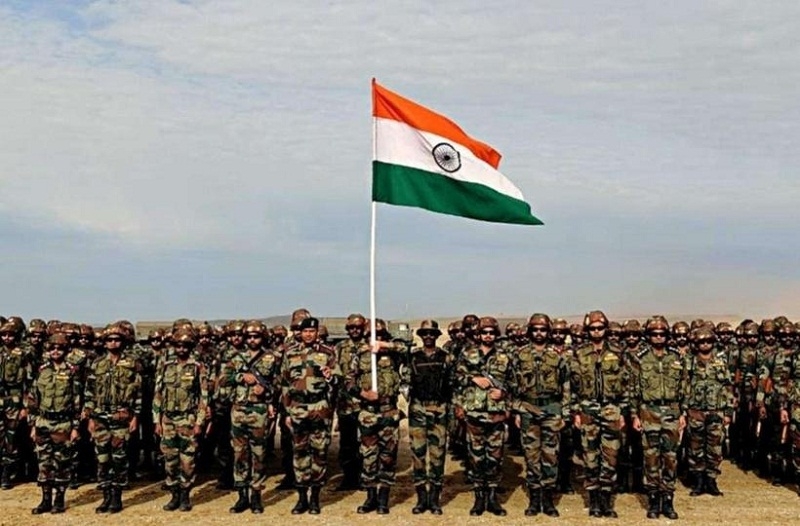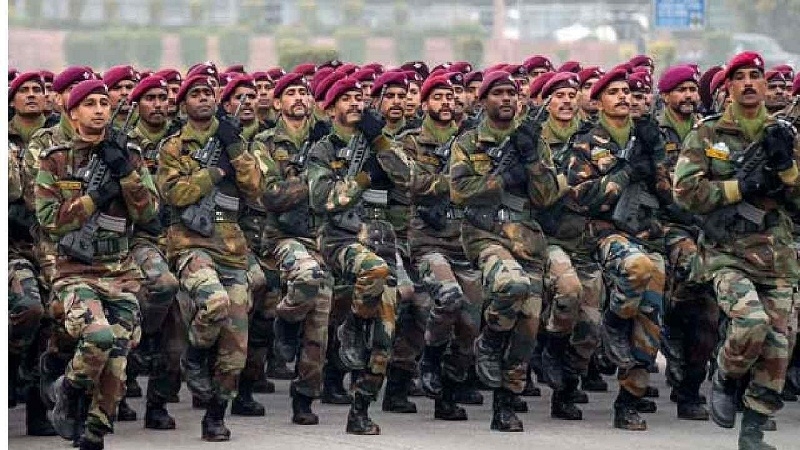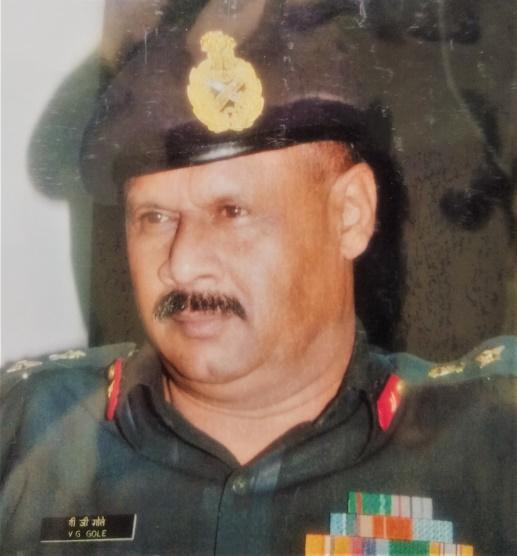De-Colonization of Indian Armed Forces

Indian Armed Forces are globally recognized as very well-disciplined, well-trained, and Modern Fighting machines and have a proven record of Military victories in adverse situations and in very difficult terrain. The basic organization and structure of the Indian Armed Forces is founded on the British Model which got further refined during World War I and II. This system is working very well and it keeps modifying itself with time and threat perception.
So do we need any change in the Organization and structure of our proven and established Fighting machine? The answer is NO. Then what is it that requires a change? For that let us analyze the whole gamut of Colonial Power, its interest, and its method of governance to come up with logical recommendations.
Historic Preamble: In 1499 Vasco-de-Gama established a sea route from Europe to India and the Portuguese started their trading. Shortly after that other European powers i.e. the British, French, Dutch, and Belgium also started their Indian ventures. Due to their Naval Superiority, the British were able to establish their trading posts on the Western and Eastern coasts of India very rapidly. To protect their trading posts and ware-houses the East India Company use to keep about 100 British Soldiers (Riflemen) at these posts along with about 200 Native Soldiers under British Sergeants and Officers. This Force was proved to be adequate to guard the trading assets of the East India Company (EIC).
The EIC would have continued trading but after getting the Zamindari Rights from Nabab of Murshidabad in Bengal, they realized that it was much more lucrative and beneficial to earn revenue through Zamindari than trading. After getting Zamindari rights, the income of the EIC increased many folds. Once the EIC tested the wealth accruals through the revenue model of Zamindari than trading, they started increasing their footprint in India. For this, they first moved some British Units from England, and with better weapons, better organization, and prudent military leadership they managed to expand the British Empire. However, while the opportunity to expand was plenty there was a limitation in the availability of British Troops.
To overcome this deficiency the British started raising Native Units (Indian Soldiers under British Officers). Since the British realized that Indian troops were ready to fight their own clan on orders of their masters, they started increasing Native units and started employing them for expanding the Empire and to quell any armed uprising within the Empire.
In short, for the Imperial Colonial power, the British Indian Army i.e. the Colonial Army was a mercenary force whose financial viability was dependent on the quantification of profits due to the Protection and Expansion of the Empire’s interests.
This historic perspective is necessary to exactly understand the difference between a Colonial Army and a National Army as elaborated below.

Aim: National Army fights for National interests. It represents the will of the nation to use force when necessary.
Colonial Army basically fights against the enemies of its master’s expanding interests.
Honor and Ego: National Army fights for the honor of the nation.
Colonial Army fights for the greed and ego of its master.
Opportunities of Engagements: National Army keeps it self-trained and well-equipped to fight a war when it is generally forced on the nation.
Colonial Army will always be deployed to expand the empire and its master’s financial interests.
In War Times: When a National Army is engaged in war, it is the nation itself that is at war.
A Colonial Army fighting a war does not mean that the nation is at war.
Peace Time: A modern, well-organized, and well-trained National Army, acts as a deterrent against misadventure and hence it generally has a prolonged period of No/ Low war and a very short period of intense engagement with full might.
A Colonial Army mostly remains engaged in war and has very little peacetime exposure as an organization.
Mobilization Time: National Army in our context, prepares for war in a manner of giving graded responses. It is ready up to a level all the time and can achieve full combat potential based on the way the situation aggravates.
Colonial Army has to be ready all the time to mobilize in a very short time as its deployment is based on opportunities to expand its colonizer’s empire or protect it, anywhere in the world.
Scaling and Stocking Levels: The National Army has to maintain certain levels of Arms / Ammunition and other stores, up to a pre-determined level all the time but has sufficient time to build up complete Scales and Stocks based on threat levels.
A Colonial Army has to be fully scaled and stocked all the time for instant mobilization.
Local Resources and Population Support: National Army will always get the full support of the Population and full National Resources as the top priority during mobilization and during the war.
Colonial Army can never be assured of local support and in all probability they may face a hostile response on mobilization from Local Population.
The conclusion from the above Analysis: While the necessary strength of Armed forces has to be maintained at all times to fight an intense all-out war, a National Army has enough uncommitted or partially committed resources within itself to employ for its own management in peacetime without adversely affecting its Combat role. When necessary and in war the same management can be taken over by other agencies of the Nation.
Organizations Required for Sustenance of Armed Forces: A Nation has to sustain its Armed Forces in two different situations. One is when at War and the second is during Peace. The Armed Forces also have two distinct roles to play. The First one is to fight War and the Second one is to remain prepared for all-out war. The first role is common for both the National and a Colonial Army as military strategies and tactics are common to gain maximum advantage in combat.
However there is a marked difference in the second situation for a National Army and a Colonial Army brought out as above, and it is here the MoD has to restructure itself by doing away with Colonial Relics since now we have a National Army.
The British Way of Maintaining a Colonial Army:
While writing about it one has to simultaneously consider the then prevailing situation in India (Pre 1947) and the non-availability of Technical, HR, and Industrial products and the power of present-day IT, Communication technologies, and Industrial development. This is essential to check in totality, the efficacy of the organizations raised in Colonial times and which are still continuing (Colonial Relics).
British Cantonments: The Colonial Army was always kept away from the Civilian Areas in order to provide them with wide areas for training and keep them segregated from the local populace. Presently a separate cadre called ‘Indian Defence Estate Service’ consisting of Group A and Group B Officers manages these Cantonments and MoD’s Real Estate. The Need for such an exclusive cadre now requires a review, especially when the decision is taken to merge the civilian areas with the local bodies.
Military Engineer Services (MES): For construction and maintenance of the accommodation in Cantonments and other Civil Engineering projects, local technical expertise was nearly non-existent and hence the British Army Engineers were providing the technical advice and the contractors were providing Labor, Material, and Supervision. In due course lower level technical supervisory staff became available, thereby needing less British supervision at the site. So, the MES was based on a lower-level supervisory cadre from local civilians and working through contractors. The Class I i.e. Group A Officers for MES were provided by Army Engineers. This organization was able to deliver during the sudden mobilization and expansion of the Indian Armed Forces during World War I and II. MES continues to exist and expand even today when there is enough Engineering Expertise available within the Armed Forces to man it at Group A and Group B/C levels during peace times. In addition, the country has now highly technical and skilled talent and construction ability available through Contracts on a required basis. Government Engineering Institutes /Colleges are also available in all States to provide all the designing technical assistance. The Central PWD has now reached all the corners of the country and is managing works for Para Military Forces and other Central Government Services.
Under the circumstances is it necessary to have a separate IDSE Service and allied Contracting and Architectural Service Cadre of civilians to carry out these tasks exclusively for the Armed Forces? The civilian Group A cadre was created to handle large Civil Engineering projects for which necessary Technical Expertise was not then available in Remote Border Areas and not for maintenance of Garrisons.
It is recommended that all Project Divisions in MES be given to CPWD and the entire Civilian Gp A and B/C Cadre be merged with CPWD for gainful employment of National Engineering Talent through a Central organization. The Garrison and Military Accommodation Maintenance work should continue to be done through Contracts, managed by Armed Forces Officers and Other Ranks to ensure their gainful employment in peacetime. In war this management can be easily taken over by CPWD or even local PWD as the Nation will be at war and not the Colonial Army.
Armed Forces HQ Cadre: This cadre was basically created to give clerical and stenographic services to the Force HQ and MoD. In due course, the cadre expanded itself and now has a Group B-level entry of Officers who rise up to the DDG level. In colonial times when the availability of clerical skills and English language proficiency was low, the cadre had a role to play. Now Indian Armed Forces have enough Clerks and Stenos and Computer operators to take over these duties in peacetime. In a war situation, there will be enough clerical and steno cadre manpower available to replace the Military persons from other Ministries whose budgetary allocations will automatically get curtailed due to war and hence will be surplus for that Ministry.
Further with the availability of Computer Databases and real-time information on the status of war preparedness due to enhanced means of communication, the overall functioning of Force HQs and MoD requires a holistic and unbiased review without any pre-mediated interests, especially with reference to logistics and HR Planning. For the secrecy of Annual Confidential Reports data and library functions, cross-force clerical military personnel can be used.
Indian Defence Accounts Service: This is an exclusive service established to provide Financial Advice, Payment, Accounts, and Audit services to the MoD. The defense budget is broadly divided into 2 parts viz. Capital Head and Revenue Head. Capital Head expenditure is done at the MoD level in Arms, Ammunition, Vehicles, and other Weapon Systems procurements along with major construction projects.
The revenue head expenditure is done at lower Military HQs and up to the unit level. Allotment and expenditure under the Revenue head are based on scaling with strict procedural guidelines. The audit is basically done to ensure that NO Unit or HQ spends funds on unauthorized items and in more quantities than scaled. Similarly, for Rations, Returns are filed with the expectation that Units may consume fewer rations than scaled and hence there will be saving to the exchequer. However, it is a fact that no unit spends and consumes anything below its scaled levels. Today with computerization it is possible to control and limit the Issue and Expenditures up to scaled levels. So once it is done there will be no requirement for audits at the Unit Level and a large quantum of manpower which is paid more than what it saves can be considerably reduced.
As regards the Financial Advisers, they are actually procedural Advisers and Not at all Financial Advisers as they have No Domain Competence to evaluate and give economical options. The procedural aspects can be guided through a line help menu in a centralized uniform and economical manner than creating manning and staffing posts that have no positive role-playing ability. In fact, such redundant establishments are actually a hindrance in functioning.
Director General Quality Assurance: This organization needs to be divided into two parts. A Standard Specification Holding Organization (SSHO) includes the Laboratories and another is a Sample Testing Organization. While the SSHO can have permanent staff, the Sample Testing teams should come from the user units who have a direct bearing on the quality of the items provided. The testing as per SOP can be carried out by all user units in rotation.
Border Roads Organization: This Organization was exclusively raised to construct Roads in the Border Areas when No Private or Government Organization was able to work in those areas. This organization has played its role effectively and now the time has come to reduce its scope as enough Private Contractors and Consultants are available for executing very challenging projects in these remote areas.
However, maintenance of certain strategic roads will have to remain with a dedicated Organization. So the BRO should be pruned and reorganized for its new role.
Ordinance Factories: Since the Government has already revised its role, and organization and linked its performance to Profit for survival, they have to now prove themselves without the protection of budgetary support. Hence at this stage, no further review is considered necessary.
Recommendations:
Provision of Inescapable Manpower: It is possible that some functions of these Colonial Relics will still be required to be done but for that, no separate Cadres are required. In fact, the system suggested is to select Officers so required from the Lt Col / Col overlooked for promotion. They can be given the option to opt for these posts and after 3/ 6 months of training, they can be very gainfully employed. They can serve till the age of 60 and then they can be given a pension as per OROP.
For subordinate manpower, a similar system can be devised for selecting overlooked NCOs / JCOs and appointing them to serve till the age of 60, and then giving them pensions as per OROP.
For All Stores, Equipment, Clothing, Spares, and Consumables: We have been running our CSD Stores for last so many years whose inventory these days is above 100,000 items. It is a two-tier system based on one unit dependent on one Mother Depot for all its demands. The Mother depots procure things through CSD HQ in Mumbai and the Marketers straightway supply them to respective depots. Units forward their demands to these depots on a monthly basis and the same is provisioned by the Depots based on economic limits laid down for respective units.
A similar two-tier system should be now made for Armed Forces for its scaled stores. It will work very well as the Subscriber base will be only around 5000 Units/HQS/Establishments. Since it will be based on scaling, even automatic forward supply may be possible without a demand. During war times the Nation will ensure all the provisioning through all resources under its command.
To Conclude:
Continuity Resulting in Systemising Corruption as a Matter of Right: The individual honesty level of British Officers in India was very high, but still the Empire ensured that NO Officer remained in the same position/setup, for more than 3 years. This ensured that no undue advantage was given to or taken from anybody due to prolonged association. However, post-Independence, the Colonial Relic organizations as described above remain in contact with the same people (Vendors and Contractors) throughout their service. In fact, they have started calling this continuity of association an efficient system and justified their own existence as being sole and exclusive operators of this system. This results in the creation of a hierarchical system of corruption that does not get interrupted due to their monopoly.
The Characteristics of an Organization and Impediments in Restructuring: Like humans, every Organization has a distinct sense of survival, it refuses to accept its redundancy due to age, it works as a trade union along with similarly placed organizations, and uses all types of methods and maneuvers to continue its existence by constantly trying to expand its footprint.
The Organizations mentioned above were created for the Colonial Armed Forces. With the formation of the National Army, they have nearly lost their significance now. However, they will resist any and every change that threatens their survival. If you take feedback from Users i.e. The Armed Forces, for whom these were created, it will be common feedback that these organizations have entrenched themselves so much that they have developed a mindset that “Armed Forces are for them, then, they being for Armed Forces.” The entrenchment of such feelings in the mindset of any supporting organization is the touchstone test of their redundancy.
Finally: With the concept of the National Army and our power in software, the time has come to do away with redundant Organizations and re-engineer procedures made and established by a colonial government for 200 years.
The Armed Forces of a nation are the last bastion of defense and it is not a laissez-faire, welfare organization to please the electorate and trade unions. Hence, continuous modernization is the key to remain focused. While the financial crunch cannot be passed to defense budgets as anything less than required makes the whole effort and investment futile, it is essential that redundant expenditures are identified and ruthlessly curtailed.


